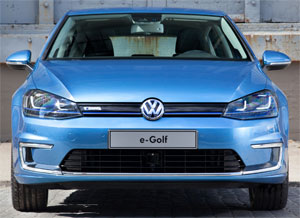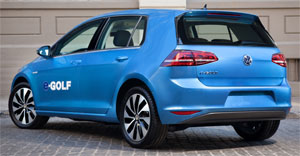The Volkswagen Golf lineup earned our 2015 Drivers’ Choice Award for best small car. One of the reasons being the wide variety of choices you have when it comes to buying one. You can go basic with a TSI, sporty with the GTI, or long range with the TDI. And, there’s even a totally green one on that list, the e-Golf EV.
It’s not only us that have showered high praise on the 7th generation, 2015 Volkswagen Golf; as 57 veteran auto writers also picked it as the 2015 North American Car of the Year. Our mission here, is to spend some additional time in the all-electric e-Golf to see if it indeed lives up to the rest of the family’s reputation; and if it brings anything new to the EV world.
Well, it doesn’t take any time at all behind the wheel to realize that the e-Golf drives almost exactly like every other Golf. It does feel a bit heavier, thanks to the additional 700-pounds of battery weight, but that just helps make it feel even more stable. Handling certainly feels similar, though some steering feel seems to have gone missing.
 Now, as for how it compares to other EVs, well it appears to be easier on range, as the distance to empty gauge seems to hang onto numbers a little longer than most before letting them count down.
Now, as for how it compares to other EVs, well it appears to be easier on range, as the distance to empty gauge seems to hang onto numbers a little longer than most before letting them count down.
Regenerative braking feel can be harsh, but it’s also adjustable. So, you can dial it up for maximum energy recuperation and brake pedal-free treks down steep hills, or dial it down for a more normal feel. One thing’s for sure, it will certainly change the way you drive, as no matter which mode you’re in, there’s not much “coasting down” to stop signs.
Drivers can also control power output by choosing between Normal, Eco, and Eco+ driving modes.
Overall, it is a very impressive piece of engineering, with almost seamless integration of all EV componentry; and it has by far the most natural throttle feel of any EV we’ve driven. It even had a few of our staffers forgetting that they were driving an EV after some time behind the wheel.
The Fed’s driving range is listed at 83-miles. Now, that’s less than both the Nissan Leaf and the Kia Soul EV, but its Government Fuel Economy Ratings of 126-City, 105-Highway, and 116-Combined MPGes beats both of them. And of course there’s an almost perfect Energy Impact Score of just 0.2-barrels of annual oil use with zero CO2 emissions.
 The powertrain is VW’s own design and features an 85-kW motor that outputs 115-horsepower and 199 lb-ft. of torque; juiced by a 24.2-kWh lithium-ion battery pack mounted beneath the rear seat.
The powertrain is VW’s own design and features an 85-kW motor that outputs 115-horsepower and 199 lb-ft. of torque; juiced by a 24.2-kWh lithium-ion battery pack mounted beneath the rear seat.
So, notably, cargo room is unchanged from other 4-door Golf hatchbacks with 22.8 cu-ft. of space in the rear, 52.7 with the seatbacks folded.
And while the new-gen Golf certainly impresses us with its ride-and-handling capabilities, interior build quality is equally impressive. The e-Golf has the same sporty feel as the rest of the lineup, and even retains elements like a flat-bottom steering wheel.
Unique components to the e-Golf include blue trim, and of course an exclusive gauge panel with a power/charge meter and a battery meter that looks exactly like a traditional fuel gauge.
 Navigation, back-up camera, heated leatherette seating, 5.8-inch touchscreen infotainment, and keyless entry are all standard. And like most newer EV efforts the e-Golf uses an efficient heat pump for cabin climate control.
Navigation, back-up camera, heated leatherette seating, 5.8-inch touchscreen infotainment, and keyless entry are all standard. And like most newer EV efforts the e-Golf uses an efficient heat pump for cabin climate control.
Things outside are a little more of a departure, with LED headlights, C-shaped LED DRLs located down low, blue trim, updated grille, 16-inch alloy wheels, and of course unique EV badging.
But, from the rear, other than the lack of a tail pipe, there’s little to indicate the e-Golf’s fossil fuel-free nature. Even the charging port is located behind the traditional fuel filler door, and the cord locks into place with the vehicles central locking system.
Available only in very well equipped SEL Premium trim, e-Golf pricing is in line with rival EVs, starting at $36,265. And of course the usual government rebates apply, bringing actual cost down to $28,765.
The 2015 Volkswagen e-Golf with its solid feel, terrific handling, and great throttle response, is a true high water mark for mainstream EVs. And much like the equally new and impressive Kia Soul EV, the more time we spend in them, the more EVs start to make sense. They even have us thinking that a plug-in driving future might not be so hard to take after all.
Specifications
- Engine: 85-kW electric motor
- Horsepower: 115
- Torque: 199 lb-ft.
- EPA: 126 mpge city/ 105 mpge highway
- Energy Impact: 0.2 barrels of oil/yr
- CO2 Emissions: 0
Long Term Updates
Mileage: 3,000So far, our petroleum-free Volkswagen e-Golf long-term electric car has been problem-free, smooth, and ultra-quiet.
But, with only 3,000 miles on the clock, we’re still in the “get-to-know-you-phase”.
The feds lists the eGolf’s range at 83-miles. Yet, with careful driving and maximum regen braking dialed in, you can easily do much more. Around town and on commutes we’re impressed at how slowly the range decreases. Only on the open highway does it plunge as rapidly as rivals, but they don’t have this EV’s GTI-like handling.
So, it doesn’t take too much time behind the wheel to realize that this car is the home run of current EVs.
Mileage: 3,700Admittedly, trips in our Volkswagen e-Golf have been mostly of the short variety, having only racked up 3,700–miles so far in our 2-months with Volkswagen’s first pure-EV. But we’re slowly venturing further afield, with a good grasp on how far we can push the e-Golf before needing a recharge.
That confidence has also been enhanced by a new 220-volt charger, helping us get a full charge in about half the time compared to 110.
Most comments from our driver’s log center around how much the e-Golf feels just like a typical VW. Which is to say there are no weird EV eccentricities; just all Volkswagen Golf sporty feel in a gasoline-free package.
A very nicely equipped package at that, as in SEL Premium trim, backup camera and navigation are standard.
Mileage: 4,300It’s with much sadness that we bring you the following news about the 2015 Volkswagen e-Golf… …it’s no longer here!
And that’s the only negative that we can come up with after our 3-month 4,300-mile plug-in adventure, except for some odd noises that emanated from the climate control system on startup.
We’re very much in love with the whole Golf lineup, and our time spent in the e-Golf has only deepened our affection.
Much like the GTIs that recently passed through our long-term fleet, the e-Golf is way more enjoyable than the typical 4-cylinder hatchback, with every stoplight reminding you of its awesome EV torque.







 Now, as for how it compares to other EVs, well it appears to be easier on range, as the distance to empty gauge seems to hang onto numbers a little longer than most before letting them count down.
Now, as for how it compares to other EVs, well it appears to be easier on range, as the distance to empty gauge seems to hang onto numbers a little longer than most before letting them count down.  The powertrain is VW’s own design and features an 85-kW motor that outputs 115-horsepower and 199 lb-ft. of torque; juiced by a 24.2-kWh lithium-ion battery pack mounted beneath the rear seat.
The powertrain is VW’s own design and features an 85-kW motor that outputs 115-horsepower and 199 lb-ft. of torque; juiced by a 24.2-kWh lithium-ion battery pack mounted beneath the rear seat. Navigation, back-up camera, heated leatherette seating, 5.8-inch touchscreen infotainment, and keyless entry are all standard. And like most newer EV efforts the e-Golf uses an efficient heat pump for cabin climate control.
Navigation, back-up camera, heated leatherette seating, 5.8-inch touchscreen infotainment, and keyless entry are all standard. And like most newer EV efforts the e-Golf uses an efficient heat pump for cabin climate control.





































